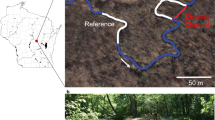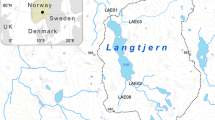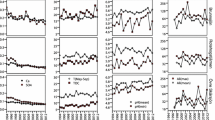Abstract
Reductions in sulfur emissions have initiated chemical recovery of surface waters impacted by acidic deposition in the Adirondack region of New York State. However, acidified streams remain common in the region, which limits recovery of brook trout (Salvelinus fontinalis) populations. To investigate liming as a method to accelerate recovery of brook trout, the channels of two acidified streams were limed annually from 2012 to 2015, and an entire watershed of a third acidified tributary was limed by helicopter in 2013. Stream flow, water chemistry, and density of young-of-year (YOY) brook trout were measured in limed streams, an untreated acidified stream, and a buffered reference stream. Lime additions increased pH and acid-neutralizing capacity and decreased inorganic monomeric aluminum concentrations to less than 2.0 μmol/L, the minimum concentration at which in situ brook trout mortality has been documented. However, of the two channel-limed streams, only stream T8 showed a significant response (P < 0.01) in YOY density, increasing from a mean of 0.4 fish/m2 before liming to 2.7 fish/m2 after liming. No YOY brook trout response was observed in the stream within the limed watershed. Groundwater inputs to streams were identified by relative differences in temperature and concentrations of silica and sodium. YOY brook trout densities increased only in the channel-limed stream (T8) with suitable groundwater inputs for fall spawning and a summer nursery. Results suggest that targeted liming of acidified streams with the necessary groundwater habitat could be beneficial in accelerating recovery of brook trout populations.








Similar content being viewed by others
References
Baker, J. P., Gherini, S. A., Christiansen, S. W., Munson, R. K., Driscoll, C. T., Newton, R. M., Gallagher, J., Reckhow, K. H., & Schofield, C. L. (1990). Adirondack Lakes Survey: an interpretive analysis of fish communities and water chemistry, 1984–1987. Ray Brook: Adirondack Lakes Survey Cooperation https://www.osti.gov/scitech/servlets/purl/6173689.
Baldigo, B. P., Lawrence, G. B., & Simonin, H. A. (2007). Persistent mortality of brook trout in episodically acidified streams of the southwestern Adirondack Mountains, New York. Transactions of the American Fisheries Society, 136, 121–134.
Biro, P. A., Ridgway, M. S., & Noakes, D. L. G. (1997). The central-place territorial model does not apply to space-use by juvenile brook charr Salvelinus fontinalis in lakes. Journal of Animal Ecology, 66, 837–845.
Cho, Y., Driscoll, C. T., Johnson, C. E., & Siccama, T. (2010). Chemical changes in soil and soil solution after calcium silicate addition to a northern hardwood forest. Biogeochemistry, 100, 3–30.
Clayton, J. L., Dannaway, E. S., Menendez, R., Rauch, H. W., Renton, J. J., Sherlock, S. M., & Zurbuch, P. E. (1998). Application of limestone to restore fish communities in acidified streams. North American Journal of Fisheries Management, 18, 347–360.
Curry, R. A., Noakes, D. L. G., & Morgan, G. E. (1995). Groundwater and the incubation and emergence of brook trout (Salvelinus fontinalis). Canadian Journal of Fisheries and Aquatic Sciences, 52, 1741–1749.
Downey, D. M., French, C. R., & Odum, M. (1994). Low cost limestone treatment of acid sensitive trout streams in the Appalachian Mountains of Virginia. Water, Air, and Soil Pollution, 77, 49–77.
Driscoll, C. T., & Newton, R. M. (1985). Chemical characteristics of Adirondack lakes. Environmental Science & Technology, 19, 1018–1024.
Driscoll, C. T., Cirmo, C. P., Fahey, T. J., Blette, V. L., Bukaveckas, P. A., Burns, D. A., Gubala, C. P., Leoplod, D. J., Newton, R. M., Raynal, D. J., Schofield, C. L., Yavitt, J. B., & Porcella, D. B. (1996). The experimental watershed liming study: comparison of lake and watershed neutralization strategies. Biogeochemistry, 32, 143–174.
Driscoll, C. T., Lawrence, G. B., Bulger, A. J., Butler, T. J., Cronan, C. S., Eagar, C., Lambert, K. F., Likens, G. E., Stoddard, J. L., & Weathers, K. C. (2001). Acidic deposition in the northeastern United States: sources and inputs, ecosystem effects, and management strategies. BioScience, 51, 180–198.
Driscoll, C. T., Driscoll, K. M., Fakhraei, H., & Civerolo, K. L. (2016). Long-term temporal trends and spatial patterns in the acid-base chemistry of lakes in the Adirondack region of New York in response to decreases in acidic deposition. Atmospheric Environment, 146, 5–14.
George, S. D., Baldigo, B. P., Lawrence, G. B., & Fuller, R. D. (2018). Effects of watershed and in-stream liming on macroinvertebrate communities in acidified tributaries to an Adirondack lake. Ecological Indicators, 85, 1058–1067.
Josephson, D. C., Robinson, J. M., Chiotti, J., Jirka, K. J., & Kraft, C. E. (2014). Chemical and biological recovery from acid deposition within the Honnedaga Lake watershed, New York, USA. Environmental Monitoring and Assessment, 186, 4391–4409.
Kraft, C. E. (2019). Adirondack brook trout and acid rain: environmental legislation fosters successful restoration. In C. Krueger & W. W. Taylor (Eds.), From catastrophe to recovery: stories of fishery management success. American Fisheries Society.
Lawrence, G. B., Roy, K. M., Baldigo, B. P., Simonin, H. A., Capone, S. B., Sutherland, J. S., Nierswicki-Bauer, S. A., & Boylen, C. W. (2008). Chronic and episodic acidification of Adirondack streams from acid rain in 2003-2005. Journal of Environmental Quality, 37, 2264–2274.
Lawrence, G. B., Hazlett, P. W., Fernandez, I. J., Ouimet, R., Bailey, S. W., Shortle, W. C., Smith, K. T., & Antidormi, M. R. (2015). Declining acidic deposition begins reversal of forest-soil acidification in the Northeastern U.S. and Eastern Canada. Environmental Science & Technology, 49, 13103–13111.
Lawrence, G. B., Burns, D. A., & Riva-Murray, K. (2016). A new look at liming as an approach to accelerate recovery from acidic deposition effects. Science of the Total Environment, 562, 35–46.
Newton, R. M., Weintraub, J., & April, R. (1987). The relationship between surface water chemistry and geology in the North Branch of the Moose River. Biogeochemistry, 3, 21–35.
Newton, R. M., Burns, D. A., Blette, V. L., & Driscoll, C. T. (1996). Effect of whole catchment liming on the episodic acidification of two Adirondack streams. Biogeochemistry, 32, 299–322.
Perkins, D. L., Krueger, C. C., & May, B. (1993). Heritage brook trout in northeastern USA: genetic variability within and among populations. Transactions of the American Fisheries Society, 122, 515–532.
Peters, N. E., & Driscoll, C. T. (1987). Hydrogeologic controls of surface-water chemistry in the Adirondack region of NewYork State. Biogeochemistry, 3, 163–180.
Porcella, D. B., Driscoll, C. T., Schofield, C. L., & Newton, R. M. (1995). Lake and watershed neutralization strategies. Water, Air, and Soil Pollution, 85, 889–894.
R Core Team. (2016). R: a language and environment for statistical computing. Vienna, Austria: R. Foundation for Statistical Computing.
Rantz, S.E. (1982). Measurement and computation of stream-flow. U.S. Geological Survey Water Supply Paper 2175.
Schofield, C. L. (1976). Acid precipitation: effects on fish. Ambio, 5, 228–230.
Schofield, C. L. (1993). Habitat suitability for brook trout (Salvelinus fontinalis) reproduction in Adirondack lakes. Water Resources Research, 29, 875–879.
Schofield, C. L., & Keleher, C. (1996). Comparison of brook trout reproductive success and recruitment in an acidic Adirondack lake following whole lake liming and watershed liming. Biogeochemistry, 32, 323–337.
Smith, E.P. (2002). BACI design: Encyclopedia of environmetrics.
Sullivan, T. J., Mcdonnell, T. C., Nowicki, N. A., Snyder, K. U., Sutherland, J. W., Fernandez, I. J., Herlihy, A. T., & Driscoll, C. T. (2006). Acid-base characteristics of soils in the Adirondack Mountains, New York. Soil Science Society of America Journal, 70, 141–152.
U.S. Geological Survey (2017) National Water Information System—Web interface. Accessed 1 June 2017 at https://doi.org/10.5066/F7P55KJN
U.S. Geological Survey (2018) National Water Information System—Web interface. Accessed 15 Jan 2018 at https://doi.org/10.5066/F7P55KJN
Van Deventer, J. S., & Platts, W. S. (1985). A Computer Software System for Entering, Managing, and Analyzing Fish Capture Data from Streams. Ogden: U.S. Forest Service.
Warren, D. R., Mineau, M. M., Kraft, C. E., & Ward, E. J. (2010). Relating fish biomass to habitat and chemistry in headwater streams of the northeastern United States. Environmental Biology of Fishes, 88, 51–62.
Acknowledgments
Assistance in the field and laboratory was provided by Cornell University staff and students including K. Jirka, E. Randall, J. Chiotti, E. Camp, L. Collis, T. Daniel, S. Duggan; U.S. Geological Survey staff; and numerous summer interns and volunteers. The Adirondack League Club provided access to all study sites and essential support for the project. W. Keller and D. Warren reviewed an earlier version of this paper.
Funding
This research was supported by funds from the New York State Energy Research and Development Authority, the Picker Interdisciplinary Science Institute of Colgate University, and the U.S. Geological Survey.
Author information
Authors and Affiliations
Corresponding author
Ethics declarations
Disclaimer
Any use of trade, firm, or product names is for descriptive purposes only and does not imply endorsement by the U.S. Government.
Additional information
Publisher’s Note
Springer Nature remains neutral with regard to jurisdictional claims in published maps and institutional affiliations.
Rights and permissions
About this article
Cite this article
Josephson, D.C., Lawrence, G.B., George, S.D. et al. Response of Water Chemistry and Young-of-Year Brook Trout to Channel and Watershed Liming in Streams Showing Lagging Recovery from Acidic Deposition. Water Air Soil Pollut 230, 144 (2019). https://doi.org/10.1007/s11270-019-4186-x
Received:
Accepted:
Published:
DOI: https://doi.org/10.1007/s11270-019-4186-x




